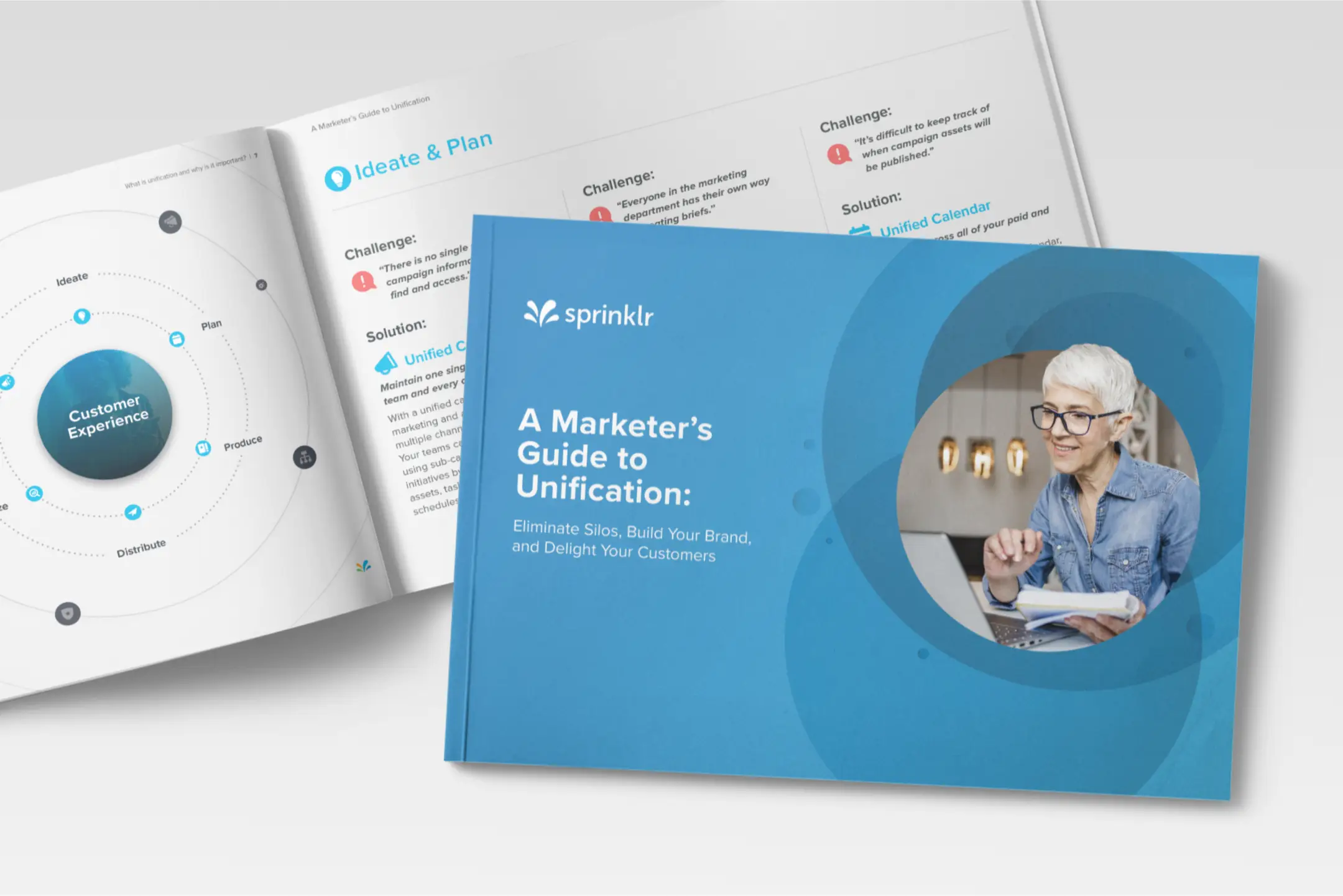Unify your marketing and advertising teams. Save costs by up to 50% and boost marketing ROI.
Streamline organic and paid campaign orchestration across 30+ channels with a unified AI-powered platform. Unlock higher productivity, faster go-to-market and better brand governance.

7 marketing automation best practices
For marketers, time is money. You just can’t let routine tasks distract you from your core objectives. Fortunately, marketing automation can be a reliable ally that takes up the burden of mundane tasks on your behalf and helps boost your marketing effort outcomes.
However, suppose you want to set up an automation process with any tool or technology. In that case, getting familiar with the ins and outs of marketing automation best practices for businesses is good. But before we delve into that, here’s a sneak peek into what marketing automation can do for you and your team.
What is marketing automation?
Marketing automation refers to the use of technology that enables businesses to automate, streamline, and optimize various marketing processes. It saves marketers time and effort by automating routine tasks such as email campaigns, social media posts, and customer segmentation. With marketing automation, businesses can create targeted and personalized messaging, analyze customer behavior, and enhance overall marketing performance.
According to Harvard Business Review (HBR), marketing automation can reduce sales cycle times by up to 50% and increase productivity by up to 20%. But that's not all.
Marketing automation also enables you to provide a personalized and seamless customer experience, leading to increased customer engagement and conversions.
A marketing automation solution acts like a personal assistant for your marketing campaigns, working tirelessly in the background to streamline and automate repetitive tasks, nurture leads and personalize customer experiences while freeing up your time to focus on strategic and creative work.
Why marketing automation is vital for your business
With the help of marketing automation best practices and software, you can target, engage and nurture leads with a personalized content plan. In addition, marketing automation allows you to easily create and manage email campaigns, social media posts, landing pages and more.
The benefits of marketing automation are numerous if you want to take your marketing efforts to the next level in 2023. With marketing automation, you can:
- Streamline and automate marketing tasks, workflows and processes
- Provide a personalized and seamless experience for customers, increasing engagement and driving more conversions
- Reduce sales cycle times
- Nurture prospects to generate more qualified leads

7 marketing automation best practices
- Focus on dynamic lead nurturing
- Simplify marketing analysis and lead scoring
- Build a clear buyer journey map
- Track your performance metrics
- Integrate your marketing automation system with CRM
- Focus on email marketing and reputation
- Leverage content as a catalyst to fuel your personalization efforts
1. Focus on dynamic lead nurturing
Gone are the days of forcing leads down a predetermined path. Creating dynamic programs catering to each individual's unique journey is the key to successful lead nurturing. Create a framework that adapts to your leads' needs rather than as a rigid storyline. Each lead can choose their journey with personalized touchpoints that speak directly to their interests.
For instance, if a lead is exploring pricing options, automatically route them towards content around discounts in later stages of the program. Or, if they recently attended an event, send a personalized follow-up message or ask them about their feedback. Remember, lead nurturing isn't a one-size-fits-all approach. By building dynamic lead nurture programs, you can respond to your leads’ needs and guide them toward a successful conversion.
2. Simplify marketing analysis and lead scoring
When it comes to marketing analysis, don't overcomplicate things. Less is often more. Creating complex lead scoring systems and sifting through mountains of data for analysis might seem like the way to go, but it's not. If your analysis is too complicated, you're not getting any value. Instead, keep it simple and streamlined.
Identify your key performance indicators (KPIs) and focus on the data that matters, including your most promising leads, based on their behavior and interactions with your brand. Regularly evaluate and adjust your program based on insights gained from your analysis to optimize your marketing campaigns in real time and seize incremental opportunities.
3. Build a clear buyer journey map
To build a successful marketing automation strategy, it's crucial to understand your buyer’s journey. You need to anticipate their needs, answer their questions and offer solutions at the right time to guide them toward conversion. By mapping out the buyer’s journey, you can create a tailored engagement workflow that speaks to your audience at every stage. This will help you boost your conversion rate and establish long-lasting relationships with your customers.
However, remember that buyer journey mapping is a never-ending process that requires constant refinement and adaptation. You must regularly analyze customer feedback and insights to ensure your workflow remains effective and up-to-date. With the correct customer journey mapping, you can create a seamless and personalized experience for your customers, resulting in better engagement and increased revenue for your business.
4. Track your performance metrics
Though marketing automation is a powerful tool to shape your marketing workflows, it's not a set-it-and-forget-it solution. Once you've set up your automation, don't just sit back and relax. Keep a close watch on your performance metrics to understand what's working and what's not.
- How many leads did you generate?
- How many conversions did you achieve?
- Did you meet your ROI goals?
Regularly monitor key metrics such as lead generation, conversion rates and ROI to understand your campaigns' performance. These insights will help refine your strategy and optimize your workflows for better results. But don't stop there.
Even if you think you've reached the peak of optimization, try running A/B tests to explore different user journeys, messaging and content to see what resonates best with your audience. By actively monitoring your performance and adapting quickly to changes, you can stay ahead of the curve and improve your ROI.
Do you want us to get your work done quickly? Check out our marketing automation platform to manage the end-to-end marketing lifecycle.
5. Integrate your marketing automation system with CRM
A successful marketing campaign arises from the perfect blend of tools and platforms, including CRM and marketing automation systems. But having these systems in silos is like competing in a rally without the proper tires. You might be able to move forward, but it will be a bumpy ride. Integrating your marketing automation engine with CRM is the key to a smooth ride. This integration enables you to leverage the full potential of your marketing automation system, giving you a 360-degree view of your customer data, streamlining your marketing workflows, and providing a more personalized experience for your customers.
Moreover, the integration of marketing automation and CRM can help you analyze the effectiveness of your campaigns in real time, gain insights into customer behavior and make informed decisions related to campaigns. It's a no-brainer that a two-way integration between your marketing automation and CRM systems is the secret sauce behind successful marketing campaigns. So think of this integration as the lubricating oil that ensures your marketing engine runs smoothly.
6. Focus on email marketing and reputation
Email marketing can be a powerful tool to connect with your audience, but it isn’t as easy as just composing an email and blasting it to your contact list. To truly make an impact, you must build a strong email reputation that's the backbone of any successful marketing campaign. One of the key elements of a good email reputation is reachability. To ensure your emails are reaching your intended audience, you need to follow what is known as the reachability workflow. This involves carefully selecting your audience, creating engaging content and giving subscribers the option to unsubscribe when they want to.
But your job doesn’t end there. The next step is creating engaging email content that resonates with your target audience. To achieve this, you need to understand your audience's personas, what stage they are in the buyer's journey, and what problem or challenge of theirs you can help solve. You can leverage data touchpoints such as case studies, surveys and data sheets to create compelling email content in various formats, including quizzes, interactive videos, blogs, social media posts, polls and surveys for more insights. To maintain a strong email reputation, you must also regularly clean your database. This means weeding out wrong addresses, duplicates and spam traps that can harm your reputation. By keeping these in check, you can build a strong email reputation that drives conversions from subscribers who are willing to know more about your brand.
7. Leverage content as a catalyst to fuel your personalization efforts
Consumers encounter an overwhelming amount of information from various brands daily. To truly capture the attention of your target audience, you must create engaging content that effectively cuts through the noise of countless brands vying for their attention. Whether through blog posts, social media updates, videos or podcasts, your content needs to be crafted with care and attention to detail. By creating content that resonates with your audience and offers them value, you can position yourself as a thought leader and build relationships with your customers that last a lifetime.

5 mistakes you should avoid in marketing automation setup
Marketing automation can be transformative for your entire team, allowing them to focus on what matters — creativity and reach. But, as with any new technology, there are a few pitfalls to avoid. It can cost time, money, and valuable customers if not done right. This section will explore five marketing automation mistakes you should avoid at all costs.
Ignoring data quality
In a recent report, 58% of B2B professionals said access to quality data is the number one factor that most amplifies the success of their marketing automation tool. Data is the foundation of any marketing automation system, and ignoring data quality can lead to inaccurate targeting, irrelevant messaging and lost opportunities. Make sure your data is accurate and up-to-date. This can help you to craft more targeted and personalized campaigns that resonate with your audience and drive better results.
Overcomplicating workflows
Marketing automation workflows can quickly become complex and overwhelming, leading to mistakes and inefficiencies. Keep your workflows streamlined and straightforward to avoid confusion and save time.
Focusing on quantity over quality
It's easy to fall into the trap of focusing on the number of leads generated rather than the quality of those leads. This can lead to a high volume of unqualified leads and a wasted marketing budget. Concentrate on creating superior-quality leads that are more likely to convert.
Relying too heavily on automation
Marketing automation is a powerful tool, but it should not replace human interaction entirely. Make sure to balance automation with human touchpoints, such as personalized follow-up calls and emails.
Forgetting to measure the impact of automation
The ultimate goal of marketing automation is to drive revenue. Forgetting to measure the ROI of your campaigns can lead to wasted resources and missed opportunities. Use a marketing analytics tool to track your success and tweak your strategy.
To conclude, marketing automation can end mundane tasks, improve your team's productivity and augment your personalization efforts. However, you must implement the marketing automation best practices outlined above to make the most of it. And keep an eye out for potential pitfalls too.

